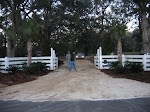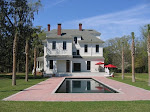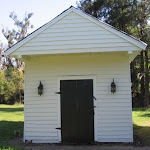The Henry Gray Turner House, “Nocturne”, was constructed in 1892 on 150 acres of land in Quitman Georgia. The house is sited at the end of a quarter-mile driveway amid a grove of hundred year old live oaks, hickory and magnolia trees. Nocturne was built for Mr. Turner from plans produced by the architectural firm Munn and Company of New York City. The original blueprints, hand drawn on vellum, were discovered in the attic, and hang in the house. The construction contractor was T.J. Darling of Waycross, GA.
Henry Gray Turner was born in 1839 in North Carolina, attended the University of Virginia and moved to Quitman in 1857 to be Headmaster of Piscola Academy, a private boys' school in Brooks County, Georgia. He remained Headmaster until 1861 when he left to fight in the Civil War with the Savannah Volunteer Guards. He eventually became captain of a company of North Carolinians and led his men at Mechanicsville, Chancelorsville and Gettysburg. At Gettysburg he was wounded, left for dead, and eventually captured. He was imprisoned for 18 months and in 1864 was discharged and sent to Richmond as a disabled soldier unfit for military service. He slowly made his way back to Quitman where he married. He was admitted to the Georgia Bar in 1865, served in the Georgia State House of Representatives from 1874-1878, and was a member of the US House of Rep from 1880-1896. At the time, he was named one of the 6 greatest men in Congress and served as Chairman of the Committee on Elections and on the Ways and Means Committee. In 1903 Turner was appointed to the Georgia Supreme Court. He died soon after on June 9, 1904. When his widow died in1911, their bachelor son S. Morton Turner inherited the house and lived there until his death in 1960.
The house is approximately 6,000 square feet in size and most all of the original details remain. Some unique exterior elements are the paired cigar columns on pedestals surrounding the porch and supporting the large pediment over the main entrance, the metal scrollwork, swags and garlands in the porch pediment and balcony entablature, and the grouped modillion blocks over the windows. The interior has 13 foot ceilings on the first floor and twelve foot ceilings on the second floor, narrow crown and picture moldings, five sets of double pocket doors, eight corner fireplaces with original mantles, fireplaces in the entrance hall and kitchen, a built-in curly pine mirrored sideboard in the dining room, two full height walk-out windows, and full transoms over all hinged doors, including the doors to all closets. There are working speaking tubes from several areas of the house to the kitchen, and an original bathroom on the second floor contains all of its original fixtures including the toilet, sink and zinc covered copper bathtub.
Since being built, only minor changes have been made to the original floor plan. A back porch has been converted to a bathroom and sun porch and the fifth second floor bedroom has been converted into a bathroom, dressing room and closet. The original electrical system has been replaced and central heat and air have been added to each floor. The woodwork has never been painted, and the old dirty and discolored shellac finish has been removed to reveal beautiful mellow pine.
The grounds now consist of twenty-five acres planted with live oaks, hickory, magnolias, and palms. When Turner built his home, he removed all of the native pine trees and replaced them with live oak, hickory, and magnolia, which was an unusual landscape for this part of the country. His idea was to transplant the surroundings of his youth in NC to his new home in South Georgia. Other structures on the property include the original smokehouse, a later carriage house, a large party house, a barn, and a two bedroom guest house created from two original servants’ houses. The house and grounds were placed on the National Register of Historic Places on January 2, 1980, for their significance in historic architecture, landscape design, and political and judicial history.
Regarding Henry Gray Turner’s later years at Nocturne, an editorial in the Atlanta Journal stated:
Here is a man passing a tranquil existence with his family and his library. Every morning he looks with satisfaction upon his beautiful trees. A visit to Mr. Turner in his home is a privilege and recalls the lines of Goldsmith:
“How blest it is to end in shades like these a life of labor with an age of ease.”
Thursday, August 9, 2007
Subscribe to:
Post Comments (Atom)









1 comment:
I want more pictures...how is the new dc house coming?
Post a Comment